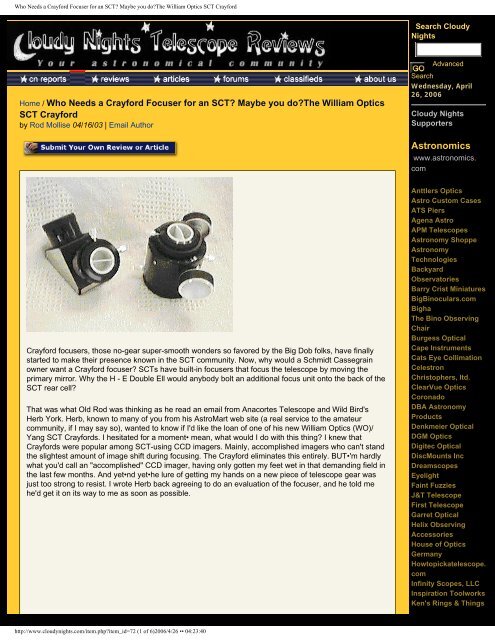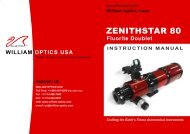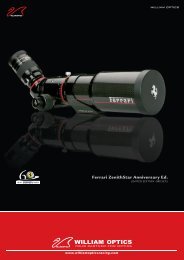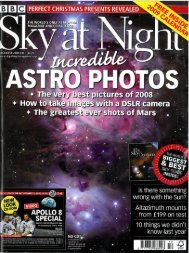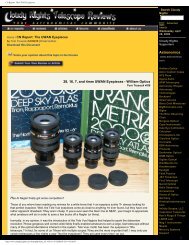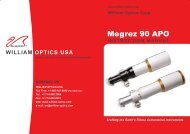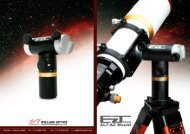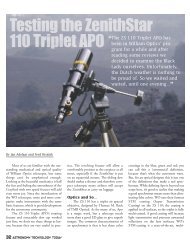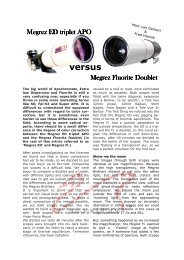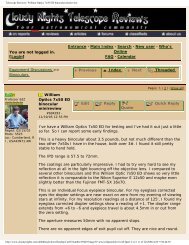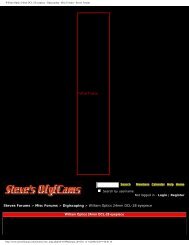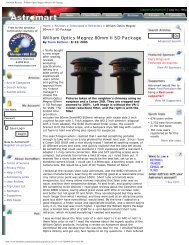Who Needs a Crayford Focuser for an SCT? Maybe ... - William Optics
Who Needs a Crayford Focuser for an SCT? Maybe ... - William Optics
Who Needs a Crayford Focuser for an SCT? Maybe ... - William Optics
- No tags were found...
Create successful ePaper yourself
Turn your PDF publications into a flip-book with our unique Google optimized e-Paper software.
<strong>Who</strong> <strong>Needs</strong> a <strong>Cray<strong>for</strong>d</strong> <strong>Focuser</strong> <strong>for</strong> <strong>an</strong> <strong>SCT</strong> <strong>Maybe</strong> you doThe <strong>William</strong> <strong>Optics</strong> <strong>SCT</strong> <strong>Cray<strong>for</strong>d</strong><br />
Search Cloudy<br />
Nights<br />
Adv<strong>an</strong>ced<br />
Home / <strong>Who</strong> <strong>Needs</strong> a <strong>Cray<strong>for</strong>d</strong> <strong>Focuser</strong> <strong>for</strong> <strong>an</strong> <strong>SCT</strong> <strong>Maybe</strong> you doThe <strong>William</strong> <strong>Optics</strong><br />
<strong>SCT</strong> <strong>Cray<strong>for</strong>d</strong><br />
by Rod Mollise 04/16/03 | Email Author<br />
Search<br />
Wednesday, April<br />
26, 2006<br />
Cloudy Nights<br />
Supporters<br />
Astronomics<br />
www.astronomics.<br />
com<br />
<strong>Cray<strong>for</strong>d</strong> focusers, those no-gear super-smooth wonders so favored by the Big Dob folks, have finally<br />
started to make their presence known in the <strong>SCT</strong> community. Now, why would a Schmidt Cassegrain<br />
owner w<strong>an</strong>t a <strong>Cray<strong>for</strong>d</strong> focuser <strong>SCT</strong>s have built-in focusers that focus the telescope by moving the<br />
primary mirror. Why the H - E Double Ell would <strong>an</strong>ybody bolt <strong>an</strong> additional focus unit onto the back of the<br />
<strong>SCT</strong> rear cell<br />
That was what Old Rod was thinking as he read <strong>an</strong> email from Anacortes Telescope <strong>an</strong>d Wild Bird's<br />
Herb York. Herb, known to m<strong>an</strong>y of you from his AstroMart web site (a real service to the amateur<br />
community, if I may say so), w<strong>an</strong>ted to know if I'd like the lo<strong>an</strong> of one of his new <strong>William</strong> <strong>Optics</strong> (WO)/<br />
Y<strong>an</strong>g <strong>SCT</strong> <strong>Cray<strong>for</strong>d</strong>s. I hesitated <strong>for</strong> a moment• me<strong>an</strong>, what would I do with this thing I knew that<br />
<strong>Cray<strong>for</strong>d</strong>s were popular among <strong>SCT</strong>-using CCD imagers. Mainly, accomplished imagers who c<strong>an</strong>'t st<strong>an</strong>d<br />
the slightest amount of image shift during focusing. The <strong>Cray<strong>for</strong>d</strong> eliminates this entirely. BUT•'m hardly<br />
what you'd call <strong>an</strong> "accomplished" CCD imager, having only gotten my feet wet in that dem<strong>an</strong>ding field in<br />
the last few months. And yet•nd yet•he lure of getting my h<strong>an</strong>ds on a new piece of telescope gear was<br />
just too strong to resist. I wrote Herb back agreeing to do <strong>an</strong> evaluation of the focuser, <strong>an</strong>d he told me<br />
he'd get it on its way to me as soon as possible.<br />
Anttlers <strong>Optics</strong><br />
Astro Custom Cases<br />
ATS Piers<br />
Agena Astro<br />
APM Telescopes<br />
Astronomy Shoppe<br />
Astronomy<br />
Technologies<br />
Backyard<br />
Observatories<br />
Barry Crist Miniatures<br />
BigBinoculars.com<br />
Bigha<br />
The Bino Observing<br />
Chair<br />
Burgess Optical<br />
Cape Instruments<br />
Cats Eye Collimation<br />
Celestron<br />
Christophers, ltd.<br />
ClearVue <strong>Optics</strong><br />
Coronado<br />
DBA Astronomy<br />
Products<br />
Denkmeier Optical<br />
DGM <strong>Optics</strong><br />
Digitec Optical<br />
DiscMounts Inc<br />
Dreamscopes<br />
Eyelight<br />
Faint Fuzzies<br />
J&T Telescope<br />
First Telescope<br />
Garret Optical<br />
Helix Observing<br />
Accessories<br />
House of <strong>Optics</strong><br />
Germ<strong>an</strong>y<br />
Howtopickatelescope.<br />
com<br />
Infinity Scopes, LLC<br />
Inspiration Toolworks<br />
Ken's Rings & Things<br />
http://www.cloudynights.com/item.phpitem_id=72 (1 of 6)2006/4/26 •• 04:23:40
<strong>Who</strong> <strong>Needs</strong> a <strong>Cray<strong>for</strong>d</strong> <strong>Focuser</strong> <strong>for</strong> <strong>an</strong> <strong>SCT</strong> <strong>Maybe</strong> you doThe <strong>William</strong> <strong>Optics</strong> <strong>SCT</strong> <strong>Cray<strong>for</strong>d</strong><br />
Figure 1: The WO <strong>SCT</strong> <strong>Cray<strong>for</strong>d</strong><br />
In due course, there was a package at my door. As always, I exercised due restraint-aw, c'mon, who am<br />
I kidding I tore the box open just as soon as I got it into my hot little h<strong>an</strong>ds! They say that initial<br />
impressions are import<strong>an</strong>t. And my first impression of the WO focuser was certainly a positive one! This<br />
is <strong>an</strong> undeniably good-looking piece of equipment (see figure 1) despite its surprisingly low price of<br />
$135.00, considerably lower th<strong>an</strong> comparable units I've seen. A combination of <strong>an</strong>odized black <strong>an</strong>d bare<br />
aluminum, I had no doubt that this sucker would look pretty darned impressive h<strong>an</strong>ging off the rear cell of<br />
my Celestron Ultima C8. Despite <strong>an</strong> appear<strong>an</strong>ce of solidity, the most surprising thing about the WO<br />
focuser was its weight. It's solid, but not overly heavy. It was amazingly light in my h<strong>an</strong>ds, <strong>an</strong>d I was very<br />
relieved. I had assumed that this was going to be one heavy mother, necessitating removal of<br />
guidescopes, piggyback brackets, <strong>an</strong>d other accumulated goodies from the <strong>SCT</strong>. <strong>Maybe</strong> I'd even have to<br />
go on a counterweight hunt. Not the case at all. The focuser was just right, requiring only minor<br />
adjustments to my sliding counterweight (you will need a counterweight to achieve bal<strong>an</strong>ce with the WO<br />
in place). Beautiful construction <strong>an</strong>d machining are great. But if <strong>an</strong> accessory is so heavy that it causes<br />
const<strong>an</strong>t bal<strong>an</strong>ce problems, you just won't use it-take if from me.<br />
But how did the WO work, indoors <strong>an</strong>yway (just as you'd expect, those nasty old clouds had moved in<br />
with a venge<strong>an</strong>ce) Very well. The unit sports two large focus knobs with rubber coverings that provide a<br />
sure <strong>an</strong>d com<strong>for</strong>table grip. I played with the WO extensively inside the house on the first evening. Like<br />
the <strong>Cray<strong>for</strong>d</strong>s on my Newtoni<strong>an</strong>s, the WO has a buttery smooth focus feel. I did note, though, that the<br />
action wasn't as positive as I like. Any <strong>Cray<strong>for</strong>d</strong>, due to the gearless, roller-style mech<strong>an</strong>ism, will slip if<br />
you exert too much pressure on the drawtube or come to the end of the focus travel. The WO seemed to<br />
slip with very little pressure applied, though. Just turning the knobs a little too fast seemed to bring on<br />
some mushy-feeling slippage. I tried the knurled screw used to lock the focuser drawtube in place. Uhuh,<br />
no dice. You c<strong>an</strong> either have the focuser locked or unlocked via this setscrew-that's it. Tightening or<br />
loosening it doesn't adjust focusing tension at all. A quick email to Herb verified my suspicions that the<br />
three, small allen screws (see figure 2) on the focuser underside could be used to adjust tension. I found<br />
a small allen wrench in my scope tool box <strong>an</strong>d soon had the focus tension set more to my liking.<br />
LXD55.com<br />
Mag 1 Instruments<br />
Meade<br />
Mercury Systems<br />
Support<br />
Optical Mech<strong>an</strong>ics<br />
Particle Wave<br />
Technologies<br />
Pier-Tech<br />
ScopeGuard Cases<br />
Scope'n'Skies<br />
Scopes4rent<br />
ScopeStuff<br />
Shoestring<br />
Astronomy<br />
Software Bisque<br />
Starbuckets<br />
Starmaster<br />
Stellar Optical<br />
Stellarvue<br />
Sun River Nature<br />
Center<br />
Telescope Solutions<br />
Tele Vue<br />
Teeter's Telescopes<br />
Telescope<br />
Warehouse<br />
Think Astronomy<br />
TeleTrade<br />
TMB Optical<br />
Tscopes<br />
Ultra Darklight<br />
University <strong>Optics</strong><br />
Walt's Observing<br />
Chairs<br />
<strong>William</strong> <strong>Optics</strong><br />
Woden <strong>Optics</strong><br />
http://www.cloudynights.com/item.phpitem_id=72 (2 of 6)2006/4/26 •• 04:23:40
<strong>Who</strong> <strong>Needs</strong> a <strong>Cray<strong>for</strong>d</strong> <strong>Focuser</strong> <strong>for</strong> <strong>an</strong> <strong>SCT</strong> <strong>Maybe</strong> you doThe <strong>William</strong> <strong>Optics</strong> <strong>SCT</strong> <strong>Cray<strong>for</strong>d</strong><br />
Figure 2<br />
Turning the WO in my h<strong>an</strong>ds revealed a couple of very nice features. One that I liked very much was the<br />
rotating base. Unlock a nice, large set-screw <strong>an</strong>d you c<strong>an</strong> adjust the <strong>an</strong>gle of a camera or diagonal<br />
without loosening said camera or diagonal's set screw or adapter. Reflections <strong>an</strong>d stray light are the<br />
b<strong>an</strong>e of every observer, so I made it a point to take a flashlight <strong>an</strong>d peer down the scope end of the<br />
focuser's drawtube. What I saw was a well-blackened <strong>an</strong>d threaded tube that will definitely minimize<br />
stray-light problems. It is attention to seemingly small things like this that make a piece of gear st<strong>an</strong>d out<br />
from the pack. Oh, the setscrews <strong>for</strong> the focuser drawtube <strong>an</strong>d the 1.25" adapter included with the<br />
focuser don't touch your lovely eyepieces•hey compress brass rings that hold your accessories securely<br />
without scoring them.<br />
All I needed was a clear night. And down here in the Deep South that c<strong>an</strong> be one of the most difficult<br />
things <strong>for</strong> <strong>an</strong> astronomer to get. Finally, though, I got some good weather. Un<strong>for</strong>tunately, it coincided with<br />
a past-first-quarter Moon. But that was actually alright. Imaging <strong>an</strong>d viewing the Moon would make it<br />
easy <strong>for</strong> me to see just how well the focuser did its thing. At the high magnifications I'd use during lunar<br />
observing <strong>an</strong>d imaging <strong>an</strong>y flexure or stickiness would show up immediately.<br />
My setup on this evening was my Ultima 8 <strong>an</strong>d Starlight Xpress MX-516 CCD cam at f/20 (via barlow<br />
projection with a TeleVue Big Barlow) <strong>for</strong> imaging. For visual work, I'd use my Intes 2" diagonal <strong>an</strong>d a<br />
variety of eyepieces. The minute I screwed the WO onto my rear cell (it threads onto your rear port just<br />
like <strong>an</strong>y other accessory), a big smile covered my face-I just couldn't help it! Now that looked cool!<br />
Nothing's perfect however, least of all astronomy equipment, <strong>an</strong>d I r<strong>an</strong> into my first small h<strong>an</strong>gup when I<br />
tried to insert my Intes diagonal into the drawtube. The fit was tight. Not just <strong>for</strong> the diagonal, but <strong>for</strong> my<br />
TeleVue barlow <strong>an</strong>d <strong>an</strong>y other 2" accessories I tried. A <strong>William</strong> <strong>Optics</strong> diagonal (more on this later) I also<br />
received from Herb <strong>for</strong> review purposes was <strong>an</strong> even tighter fit th<strong>an</strong> my other stuff. I know that high-end<br />
m<strong>an</strong>ufacturers like to machine equipment to very close toler<strong>an</strong>ces, but, hey, that's the last thing most<br />
observers need out in the dark. If you have to jerk a diagonal or a barlow out of a focuser with enough<br />
<strong>for</strong>ce to move the scope, you're going to get tired of using the focuser real quick. This was not a fatal<br />
flaw, however, <strong>an</strong>d the diagonal did loosen up over the course of the evening.<br />
Working with my diagonal revealed <strong>an</strong>other minor irritation. In <strong>an</strong> ef<strong>for</strong>t to get the Intes in <strong>an</strong>d out of the<br />
focuser with the least hassle, I tended to back the focuser's setscrew off a lot, <strong>an</strong>d I'd occasionally turn<br />
too far, causing it to drop to the ground. Now, <strong>William</strong> <strong>Optics</strong> is certainly not the only offender here, but<br />
when are m<strong>an</strong>ufacturers going to get the message that we need captive setscrews on everything<br />
Nothing is more frustrating th<strong>an</strong> having a small screw drop to the ground <strong>an</strong>d hide in the grass at 2 am!<br />
Also, please be aware that the WO is a big piece of equipment. It extends quite a dist<strong>an</strong>ce back from<br />
your rear cell. This is really only a problem (focus issues aside, see below) during polar alignment. I<br />
could not leave the Intes diagonal in place with the scope pointed at a declination of 90 degrees. The<br />
focuser is just about a inch too long to allow the diagonal body to clear the base of the <strong>for</strong>k. In practice,<br />
this is not a huge difficulty. Just insert a 1.25" diagonal if you w<strong>an</strong>t to look through the main scope at this<br />
point. I use a polar alignment finder <strong>for</strong> this initial pointing at the pole, so I have no real need to look<br />
through the main scope, <strong>an</strong>yway.<br />
Yeah, sure, we all know that <strong>SCT</strong> <strong>Cray<strong>for</strong>d</strong>s are mostly used by imagers, but I thought I'd see how the<br />
WO worked <strong>for</strong> visual observing while waiting <strong>for</strong> the scope to acclimate <strong>an</strong>d the Moon to rise a little<br />
http://www.cloudynights.com/item.phpitem_id=72 (3 of 6)2006/4/26 •• 04:23:40
<strong>Who</strong> <strong>Needs</strong> a <strong>Cray<strong>for</strong>d</strong> <strong>Focuser</strong> <strong>for</strong> <strong>an</strong> <strong>SCT</strong> <strong>Maybe</strong> you doThe <strong>William</strong> <strong>Optics</strong> <strong>SCT</strong> <strong>Cray<strong>for</strong>d</strong><br />
higher. What I discovered astounded me! I'll say it right now: if you're a serious Lunar or pl<strong>an</strong>etary<br />
observer, the WO <strong>Cray<strong>for</strong>d</strong> is a godsend. Not only could I focus at very high power without <strong>an</strong>y image<br />
shift, the focus is incredibly smooth <strong>an</strong>d fine. Focusing <strong>an</strong> <strong>SCT</strong> by moving the eyepiece rather th<strong>an</strong> the<br />
primary mirror just naturally results in very slow, fine focus action. It allowed me to obtain precise, <strong>an</strong>d I<br />
me<strong>an</strong> precise, focus at magnifications of 350x <strong>an</strong>d above. The easy action of the WO also me<strong>an</strong>t that<br />
the act of focusing imparted very little vibration to the scope. My Ultima 8 has little focus shift, but I still<br />
felt that the WO gave me quite <strong>an</strong> adv<strong>an</strong>tage over st<strong>an</strong>dard focusing at high powers <strong>an</strong>d long focal<br />
lengths.<br />
How about focus travel <strong>an</strong>d compatibility with various eyepieces At f/10 I had no problems at all. Any 2"<br />
or 1.25" eyepiece came to focus easily. As I'd expected, on the other h<strong>an</strong>d, I couldn't reach focus with<br />
<strong>an</strong>y eyepiece when I screwed my f/6.3 reducer - corrector onto the rear cell. I didn't really expect this to<br />
work, mind you. The extra spacing added by the WO was just too much. I didn't have the opportunity to<br />
check the WO on the deep sky be<strong>for</strong>e it had to return to Anacortes, but I believe that it should reach<br />
focus with a camera at prime focus with the Celestron/Meade f/6.3 r/c or the Meade f/3.3 r/c.<br />
How about imaging Again, that's the reason most people will invest real money in a <strong>Cray<strong>for</strong>d</strong>. In short, it<br />
made Lunar Imaging a JOY! As I said earlier, my Ultima 8 doesn't have much focus shift to begin with.<br />
But at f/20 - f/30, the focal lengths I usually use to "shoot the Moon," even its small amount of shift<br />
me<strong>an</strong>s the Lunar feature of interest may move off the edge of my relatively small CCD chip. None of that<br />
with the WO. Focusing was quick <strong>an</strong>d precise, <strong>an</strong>d I think my results on the gr<strong>an</strong>d crater Clavius speak<br />
<strong>for</strong> themselves. During my Lunar imaging run, I didn't notice <strong>an</strong>y flexure or other problems. I do advise<br />
users to be sure to lock the focuser securely once precise focus is achieved. Bumping the camera will<br />
definitely ch<strong>an</strong>ge the focus on the WO, <strong>an</strong>d you'll get to start the focusing process all over again.<br />
Clavius the Great!<br />
Will this be a good tool <strong>for</strong> the deep sky imager I'd have to say "yes," if you're bothered by focus shift or<br />
find it difficult to focus precisely using your scope's normal control. However, please be aware that you'll<br />
have to <strong>for</strong>ego using a flip mirror when you put the WO in place. Assuming you could rig the adapters to<br />
attach the focuser to your flip mirror or vice-versa, a setup like this would place your camera too far back<br />
to achieve focus I'd guess.<br />
I should also outline the method you use when focusing with a <strong>Cray<strong>for</strong>d</strong> like the WO. The focus travel<br />
with one of these units is very short-this goes <strong>for</strong> <strong>an</strong>y <strong>Cray<strong>for</strong>d</strong> attached to <strong>an</strong> <strong>SCT</strong>. The upshot of this is<br />
that you c<strong>an</strong>not use the <strong>Cray<strong>for</strong>d</strong> all the time. When initially setting things up, you'll first find rough focus<br />
with the scope's normal focus control. When you're in the "neighborhood," you c<strong>an</strong> begin using the<br />
<strong>Cray<strong>for</strong>d</strong>. When you ch<strong>an</strong>ge eyepieces or cameras you'll often find you have to use the scope's "normal"<br />
focuser to get back into the focus r<strong>an</strong>ge of the <strong>Cray<strong>for</strong>d</strong>. This is not a big deal, but some people seem to<br />
think that a <strong>Cray<strong>for</strong>d</strong> c<strong>an</strong> completely replace the normal <strong>SCT</strong> focusing method. This is only true if you<br />
intend to only use a set of parfocal eyepiece in your telescope. In that case, the moving-mirror focuser<br />
c<strong>an</strong> indeed be left alone.<br />
http://www.cloudynights.com/item.phpitem_id=72 (4 of 6)2006/4/26 •• 04:23:40
<strong>Who</strong> <strong>Needs</strong> a <strong>Cray<strong>for</strong>d</strong> <strong>Focuser</strong> <strong>for</strong> <strong>an</strong> <strong>SCT</strong> <strong>Maybe</strong> you doThe <strong>William</strong> <strong>Optics</strong> <strong>SCT</strong> <strong>Cray<strong>for</strong>d</strong><br />
Final thoughts<br />
I was skeptical about the "need" <strong>for</strong> the <strong>William</strong> <strong>Optics</strong> <strong>SCT</strong> <strong>Cray<strong>for</strong>d</strong>, but swiftly became a convert.<br />
Make no mistake, this is something of a luxury <strong>for</strong> the average sct-using amateur-though this focuser,<br />
priced at $135.00 US$ represents a price breakthrough in <strong>an</strong> item like this, <strong>for</strong> sure. But a very useful<br />
luxury. I was already aware that a focuser like this one c<strong>an</strong> take a lot of the pain out of CCDing. But what<br />
surprised me was what a nice tool this is <strong>for</strong> pl<strong>an</strong>etary-or other high magnification--work. This is a quality<br />
piece of gear. And should hold up well under years <strong>an</strong>d years of heavy use. Plus, as I said, this thing<br />
makes even your pedestri<strong>an</strong> Celestar or LX-10 look really cool!<br />
A word about diagonalsBR><br />
In the course of our emails concerning the <strong>William</strong> <strong>Optics</strong> <strong>Cray<strong>for</strong>d</strong>, Herb York asked me if I'd also like to<br />
try his WO 2" diagonal. "Sure," sez I, "why not" I wasn't expecting <strong>an</strong>ything special when I opened the<br />
box from Anacortes. A diagonal is a diagonal right Wrong! In appear<strong>an</strong>ce, <strong>an</strong>yway, the WO diagonal is<br />
different, m<strong>an</strong>! Instead of being all black like my Intes, it features bare aluminum sides <strong>an</strong>d a gold<br />
"<strong>William</strong> <strong>Optics</strong>" nameplate on the eyepiece end of the mirror housing. My Intes reminds me of a good,<br />
solid T72 T<strong>an</strong>k, while the WO looks more like a Lexus! Like my Intes 2", this is a "refractor style"<br />
diagonal. You'll need a separate 2" visual back (AKA '2" adapter') to use this on your <strong>SCT</strong>. Luckily, I had<br />
the ch<strong>an</strong>ce to try the WO diagonal on Mars, as severe a test as you c<strong>an</strong> make, I suppose. Nice. Very<br />
nice.<br />
These things are subjective, of course. And, truly, a refractor or <strong>SCT</strong> diagonal is much less critical to<br />
optical per<strong>for</strong>m<strong>an</strong>ce th<strong>an</strong> a Newtoni<strong>an</strong>'s diagonal. And yet•nd yet•aybe it was my imagination, but I did<br />
think Mars looked slightly sharper, <strong>an</strong>d that there was less light scatter in the WO th<strong>an</strong> in my Intes. The<br />
difference was subtle, <strong>an</strong>d it may indeed have been my imagination, but this is, no doubt about it, a very<br />
nice piece of gear.<br />
Criticisms<br />
The diagonal was a very tight fit in <strong>an</strong>y accessory I tried. It did go into my Intes 2" visual back, but it took<br />
some twisting. I was never able to get it fully seated in the (already tight) WO <strong>Cray<strong>for</strong>d</strong>. On the other<br />
h<strong>an</strong>d, it would no doubt loosen up with a little use. It did fit nicely into <strong>an</strong> old Celestron 2" visual back I<br />
had lying around. Verdict Stylish to the point of being eye-popping <strong>an</strong>d a very good per<strong>for</strong>mer optically.<br />
http://www.cloudynights.com/item.phpitem_id=72 (5 of 6)2006/4/26 •• 04:23:40


